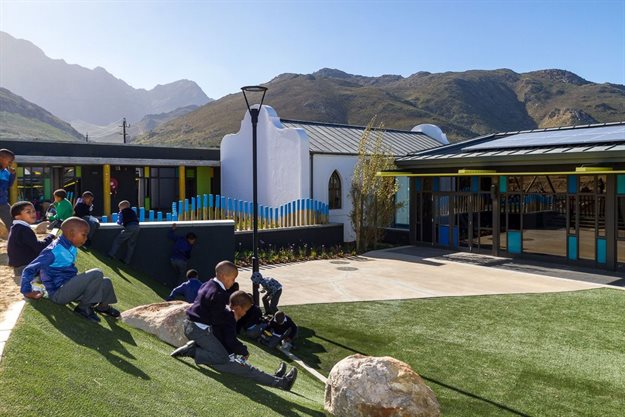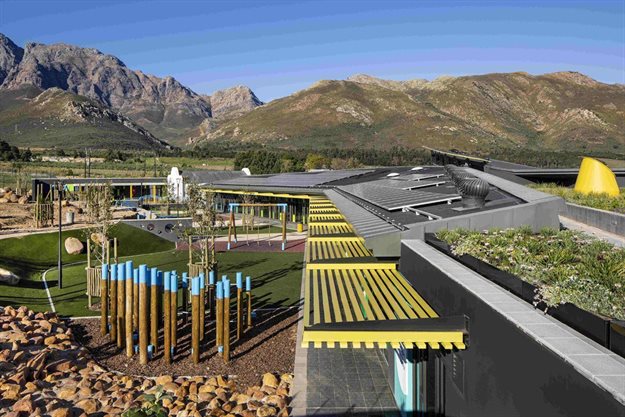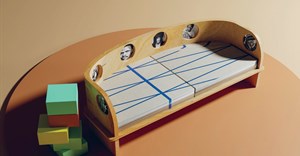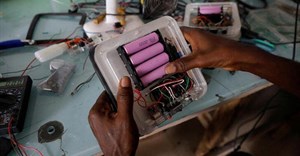Trending
Elections 2024
Jobs
- Senior Professional Officer Cape Town
- Project Administrator Johannesburg
- Architectural Draughtsman / Technician Knysna
- Junior Mechanical Engineer Randburg
- Electrician - Electrical Reticulation Experience George
- TLB Operator George
- Quantity Surveyor George
- Expediting Administrator - Engineering Sector Johannesburg
- Electrician George
- Electrical Engineer George
Public-private partnership results in upgrade for rural winelands school

According to architect Tiaan Meyer, the Botha's Halte school design applied ecological and sustainability principles, while respecting the cultural heritage of the area. "These considerations influenced the architectural form of the buildings but are also made visible throughout the complex and as such form part of the teaching and educational processes – therefore a didactic approach has been followed in the architectural design of the buildings," he says.
The original school was founded during the 1920’s and was known as “Anna Zaal”. Comprising a single hall, it served as the first school building on the property and has been restored as the new focus and reception area for the school.
The added complex sought to meld into this and the situational context. The buildings are all tucked into the landscape with the curved roofscape imitating the rolling foothills of the Witzenberg Mountain range.

Historical components remain
The external colours of the buildings are recessively dark to blend into the landscape, with only minimal bright accents. However, the historical components remain in their original white. "To the one side, the Anna Zaal reflects the link with the lime-washed building traditions of the past, and on the other, the tower represents a symbol of a green and increasingly ecologically sustainable future," explains Meyer.
"On a more subliminal level, the tower also references other distinctly regionalist typologies such as the traditional corbelled huts found scattered in the Worcester district and the lower parts of the Greater Karoo, and other natural structures such as ant heaps, which itself hold lessons for ecological design and building practice in Southern Africa."
Inside, the interiors are light and bright, with an abundance of colours to stimulate the creativity of learners. Furniture and equipment have purposely been selected with this design intent in mind.
Included as part of the school is an auditorium-type multipurpose hall, two specialist classrooms with sewing machines, handwork and woodwork equipment, as well as a science laboratory.
A Discovery Centre, where learners can gather in small groups under the “tree-of-knowledge columns”, forms the heart. Here, they make use of the multimedia equipment, computers, a screened-off audio-visual area, and library books. The area also serves as break-out space from the adjacent classrooms, for group work or individual teaching.
Operationally, the teachers involved with the school are provided continuous training for the use of the high-tech learning aids. They are also supported by the WCEDs and SUNCEP (University of Stellenbosch Centre for Pedagogy in the faculty of Education).

Interactive learning opportunities
Mark Saint Pôl, director of Square One Landscape Architects, who spearheaded the design and integration of the external elements of the school, explains that best practice landscape architecture principles have been used which allows the landscape to harvest, filter and store all excess waste and storm water run-off in a bio-filtration retention basin which also serves as a forecourt for the school. This water is then reused for irrigation and creates a natural habitat for indigenous wetland species. Dry river beds have been designed to not only prevent seasonal flooding, but create nature-play environments and interactive learning opportunities.
The building and surrounding spaces are sensitively integrated into the landscape through planted roofs that act as natural insulation to the harsh external climatic conditions. Square One incorporated a broad range of indigenous species onto the roof, promoting a multi-sensory experience for kids and teachers while minimising solar heat gain for the buildings. A substantial play space at the back of the school, featuring two Astro turf play areas (one for older learners for formal and competitive play with stepped spectator seating, and the other a secure exploratory play area for younger learners) takes full advantage of the sunken building profile to create an environment that is sheltered from the prevailing summer winds. The play elements embrace the site's unique topography to incorporate embankments for running, clambering, rope climbing and sliding.
Drawing on the agricultural patterns of the valley, Square One also created a sequence of play spaces to cater for a variety of ages and capability levels. Focusing on tactile and natural play, rockeries, sandpits and natural materials were incorporated to create an interactive environment that allows for natural expression and engagement through play. Bright blue play equipment was custom-designed to maximise opportunities for fun, exercise, social interaction and positive risk-taking while complementing the architecture and seaming it into the receiving environment. The adjacent Renosterveld area has been cleared of invasive alien species and is in the process of regeneration. Over time, it will surround the school, reducing its footprint and providing an ecological learning environment.
Food garden
Food production is an important part of the school and the addition of a citrus courtyard and a large food garden mean that the learners have the chance to grow and eat their own produce. The food garden supplies nutritional food to the feeding kitchen which is designed as part of the school building complex and forms a critical part of the WCED school feeding scheme for learners from disadvantaged communities. In addition, a partnership with the adjacent farm will allow them to use the surplus produce in their estate restaurant, Bosjes Kombuis. “Overall, the school bears testimony to the value that can be added when the architects and landscape architects work together to create truly meaningful and enjoyable projects,” comments Saint Pôl.
From an environmental perspective, new solar and wind generator capacity now allow the buildings to function largely independent of the electrical Eskom grid. The benefits of these aspects are clearly demonstrated to learners via interactive displays throughout the school.
Rain and storm water is harvested for irrigation and stored in a large reservoir under the school buildings. The reservoir is topped up by a borehole as well as with the clean, treated effluent from a sewerage package plant.














